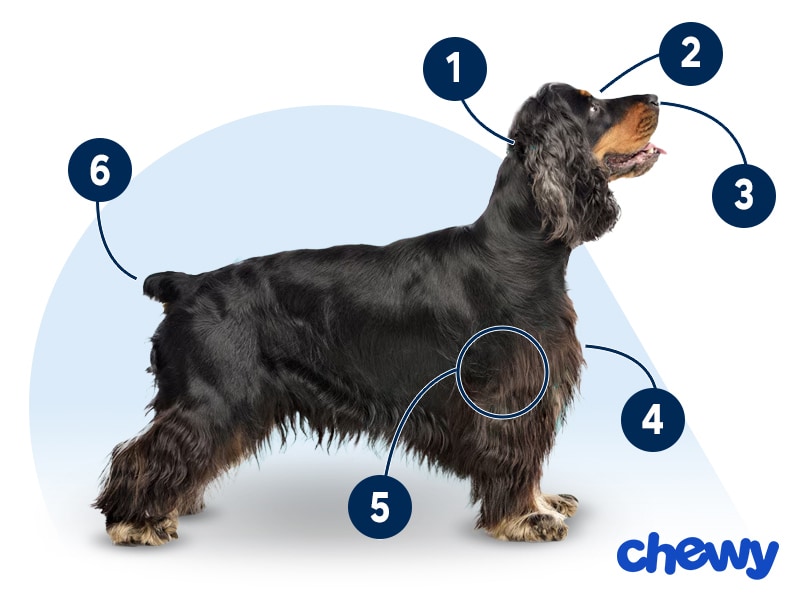Cocker Spaniel
Updated June 4, 2025
Cocker Spaniel
Updated June 4, 2025
Affectionate and fun, Cocker Spaniels are sensitive souls who love a good game of fetch and cuddling with their person in equal measure. They’re adaptable besties who can thrive in the city, country, or anywhere in between—as long as they have a special person to call their own.
Gentle, Playful, Snuggly
20–30 pounds
13.5–15.5 inches
10–14 years
Black, Black and Tan, Silver, Buff, Red, Brown, Brown and Tan, Black and White, Red and White, Buff and White, Brown and White, Black White and Tan, Brown White and Tan, Brown Roan, Brown Roan and Tan
American Cocker Spaniels are very pretty—but if they know it, they’re not letting on. These kind, unassuming dogs have lovely, floppy ears that fly in the wind when they run.
While they’re not the most active dogs in the world, they still enjoy expending their energy on fun sports, like agility training or flyball. Cockers are also heavy shedders, so it’s up to you to schedule lots of brush time; you can do it while you snuggle on the sofa and watch a movie in the evenings.
At the end of the day, these gentle pups love their outdoor playtime, but they love cozying up to their favorite person just as much.
Cocker Spaniel Characteristics
Cocker Spaniel Appearance
Think of the leading “lady” in the Disney film “The Lady and the Tramp,” and you can easily picture a Cocker Spaniel: They’re sweet dogs with long eyelashes, shampoo-commercial ears, and flowy hair on the rest of their body. Their round eyes are gentle and welcoming, often giving off a “puppy eyes” vibe.

- Ears
Cocker Spaniel ears are long and covered with well-feathered fur.
- Eyes
Their eyes are generally dark brown and round, with a slight almond shape.
- Nose
The color of their nose depends on the color of the dog, but it’s often black or brown.
- Coat Length
A Cocker Spaniel’s coat is short on the head and a medium length on the body, with feathering on the ears, chest, abdomen, and legs.
- Coat Color
Cocker Spaniels dogs come in over 20 colors, including solid colors, like black, cream, and red, and a mixture of shades, like black and white, red and white, and brown and white.
- Tail
While some Cocker Spaniel tails used to be docked, nowadays it’s common to leave their long tails intact. Many groups, including the American Veterinary Medical Association, oppose tail docking, and many countries as well as U.S. states have banned the practice.
Cocker Spaniel Temperament
Cocker Spaniels are generally happy dogs who get along with most two- and four-legged friends. This makes them a great companion for families with kids and babies or other pets. Some Cocker Spaniels make good therapy dogs, too, but it will depend on your pup’s individual temperament.
Gentle and loving, Cocker Spaniels enjoy the company of their humans. They’ll generally want to be wherever you are and won’t stray too far away. While they’re usually pretty laid-back, Cocker Spaniels are not couch potatoes and enjoy playtime with you. Many may also like dog sports like agility training.
How to Care for a Cocker Spaniel
Those locks need consistent brushing to keep tangles and shedding at bay, but the moments you spend grooming your pup—along with training and socializing—will also give you lots of quality time together.
Grooming
Training
Diet
Exercise
Environment
Cocker Spaniel Health
The typical Cocker Spaniel lifespan is 10–14 years, and there are a few health issues to watch out for.
- Ear issues: A Cocker Spaniel’s ears are long, fluffy, and adorable, but they can trap moisture inside, which can lead to many issues. Thoroughly drying their ears after baths or outside playtime can help. If you think your pup has an ear infection, talk to your vet; they may also recommend weekly ear cleaning to prevent infections.
- Eye issues: Cocker Spaniels can develop a handful of eye conditions.
- Cataracts are the most common eye problem in Cocker Spaniels, and they can be hereditary. Surgery is the go-to treatment.
- Another concern is progressive retinal atrophy, which is the degeneration of the retina that can lead to blindness. While there’s no treatment, dogs often adjust well to vision loss with a little help from their pet parents.
- Less serious, keratoconjunctivitis sicca, or dry eye, can look like red and irritated eyes and is typically treated with eye medication.
- Hip dysplasia: Hip dysplasia is when the ball and socket of the hip and thigh bones don’t properly fit together. It’s an inherited condition that can be made worse if a pup is overweight. Hip dysplasia eventually leads to arthritis, and treatment depends on the severity.
- Luxating patella: Cocker Spaniels can develop luxating patella, where the kneecap slips out of place. It may be treated with supplements and meds, if mild, though surgery may be necessary. Keeping your dog at a healthy weight can help prevent this condition.
- Skin issues: A Cocker Spaniel’s skin can get oily, so seborrhea and dermatitis are common issues. A thorough rinsing after bathing can prevent some skin problems. Your vet might also recommend medication or a shorter Cocker Spaniel haircut to help.
Cocker Spaniel History
Spain is widely considered to be the Cocker Spaniel’s country of origin. Here, they were first bred as hunting dogs, and their ancestors were considered either “land” or “water” spaniels. Eventually, those groups became more nuanced, and the dogs known for hunting the woodcock became the Cocker Spaniel.
Cocker Spaniels were one of the first breeds recognized by the American Kennel Club (AKC), in 1878. But a distinction between Cocker Spaniel breeds—the Cocker Spaniel and the English Cocker Spaniel—didn’t come until 1946.
The 1950s were a good time for Cocker Spaniels in America. They were the most popular breed of the decade, according to the AKC. This likely had something to do with then-Vice President Richard Nixon’s Cocker Spaniel, Checkers, and the popularity of the movie “Lady and the Tramp,” in which Lady is a kind, charming Cocker Spaniel.
The cost of a Cocker Spaniel puppy can be as much as $3,000. If you choose this route, pick a responsible breeder.
You can also search for a Cocker Spaniel for adoption, as there are plenty out there in need of good homes. Find Cocker Spaniel rescue dogs through a breed-specific organization, such as Abandoned Angels; keep an eye out at your local shelter or rescue; or search Chewy’s database of adoptable dogs in your area.








